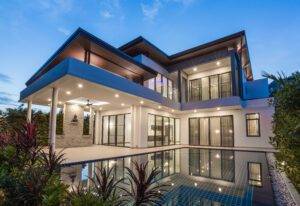Creating a vacation home is an exhilarating venture, demanding meticulous planning and reflection to guarantee that the outcome meets your desires and offers the ideal escape for unwinding.
From location and budget to sustainability and design, here are 10 key things to consider before breaking ground on your dream vacation retreat.
1. Location
The location of a vacation home holds paramount importance, shaping the essence of one’s retreat. It transcends mere geographical coordinates, becoming a key determinant of the overall experience. A carefully chosen locale can elevate relaxation or adventure, offering proximity to natural wonders, cultural hubs, or tranquil seclusion.
The right setting can harmonise with personal preferences, whether a beachfront escape for sun-soaked serenity, a mountain retreat for crisp air and scenic vistas, or a city oasis immersed in a vibrant culture. Accessibility to amenities, climate considerations, and the local community contribute to the appeal. Research and visit potential sites to ensure they align with your vision for the perfect getaway.
2. Budget
Besides construction spending, consider additional costs for obtaining permits, landscaping, and interior decoration to have both a comfortable and beautiful home. In addition, consider extra funds for additional building materials for any emergencies that may arise or additional structure.
The secret to constructing a vacation home is having a flexible budget that creates room for unexpected uncertainties and an advanced perspective incorporating future expenses like maintenance, property tax, and utilities. Work with architects, contractors, and financial advisors to ensure your budget is comprehensive and realistic. Remember, establishing a clear budget early in the planning stages will guide your decisions throughout construction.
3. Architectural Style
Your architectural style for your cabin contributes significantly to the overall ambiance and experience of your retreat. The design must suit your taste, whether you want a modern design, an old farmhouse, or a seaside home. Your style must blend with the natural surroundings. Working with the best cabin builders is essential if you are considering it.
Experienced professionals can seamlessly integrate your chosen architectural style with the surrounding environment, ensuring structural integrity, energy efficiency, and a harmonious blend of aesthetics and functionality. Whether your preference leans towards a contemporary masterpiece, a rustic cabin, or a cosy beach cottage, the architectural design should align seamlessly with your lifestyle and personal preferences.
4. Size and Layout
Choosing the right size and design for your holiday house has critical implications for comfort and financial aspects. Consider carefully addressing its intended needs and the number of people it accommodates and maintaining the right balance. While you need sufficient space to keep the environment conducive for work, construction and maintenance costs must also be factored in.
It also ensures that the project is kept within financial limits by tailoring the dimensions to your exact needs to maximise utilisation. Design a functional and sustainable home for vacation by carefully considering the size and layout that will facilitate a balanced lifestyle, a minimalistic approach to design, and long-term maintenance costs.
5. Accessibility
Before committing to a location, meticulously evaluate its accessibility and available infrastructure. While a remote location may offer unparalleled serenity, it can also pose challenges in terms of transportation and connectivity. Consider how easily you can reach your vacation home and whether the infrastructure can adequately support your needs. Striking a balance between seclusion and accessibility is vital to ensure your dream retreat is not isolated to the point of inconvenience.
6. Amenities and Features
The customization process entails identifying the desired amenities and preferences that will make your experience pleasant in your holiday home. Consider some aspects that make the place very functional, including leisure facilities like;
A pool for relaxing during summer
Outdoor living places for appreciating the scenery and nature
A cosy fireplace for hosting barbecues and keeping warm while outside
Special rooms for their hobbyist interests and extra guests.
Incorporating your preferred amenities when building the best vacation home guarantees optimal recreation of your style of living in your own haven away from your home, which leads to happiness.
7. Resale Value
Keeping in mind the future resale value will help guide the designs and features used to keep your property attractive and valuable when it comes to sale later on. Choose timeless designs and features that appeal to a broad audience to maximise the resale potential. These types of designs also add value to your home instead of just selling the property and having to cut the remodelling cost for the new buyer. Research the local real estate market and trends to ensure your investment maintains or appreciates over time. While your vacation home is a personal sanctuary, keeping an eye on its market appeal can be a wise financial decision.
8. Insurance and Permits
Investigate the insurance depending on the area where you intend to erect this type of structure and its own nature. For example, certain areas may require insurable coverage for such issues as natural catastrophes and other environmental aspects, such as natural fires, flooding, landslides, and earthquakes. Acquire the necessary permits and approvals to meet local construction standards and land ownership rules. It avoids legal difficulties and ensures that health, safety, and environmental concerns are considered during construction.
9. Environmental Impact
Consider using environmentally friendly methods by studying green construction materials and efficient energy systems to lower the environmental imprint attached to your house. Using materials that are less harmful to the environment, such as recycled or local resources, can help reduce all types of energy consumption connected with building construction.
Using energy-saving systems like solar panels, energy-saving gadgets, and appropriate insulation, one saves on energy costs in the future. Research local regulations regarding environmental impact assessments and permits to ensure your project aligns with both your values and legal requirements.
10. Property Management
A reliable property management plan ensures that your investment is well-maintained and provides a positive experience for you and any guests or renters. This includes regular inspections, addressing maintenance issues promptly, and ensuring a seamless rental process if you choose to make your vacation home available for short-term rentals. Research local property management companies or hire an individual manager to oversee bookings, maintenance, and guest interactions.
Endnote
Careful consideration of location, regulations, budgeting, and local dynamics is paramount when embarking on the construction of a vacation home. Balancing personal preferences with market trends, prioritising resilience against local weather conditions, and planning for effective maintenance contribute to the long-term success of your investment. Additionally, understanding insurance requirements, embracing community dynamics, and factoring in essential amenities ensure a holistic approach to the project. By addressing these aspects thoughtfully, you pave the way for a rewarding and enduring vacation home experience.
Read more:
10 Things to Consider Before Building a Vacation Homes















